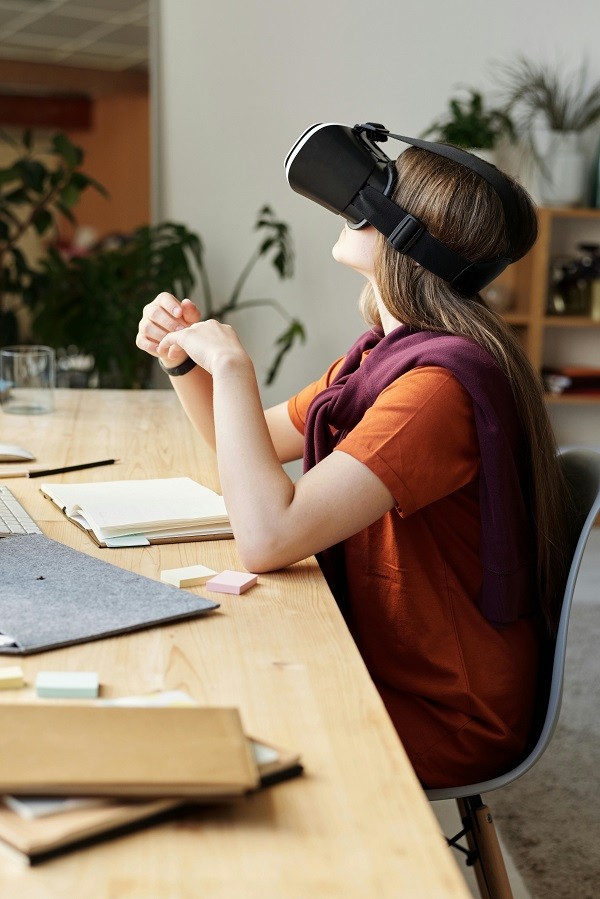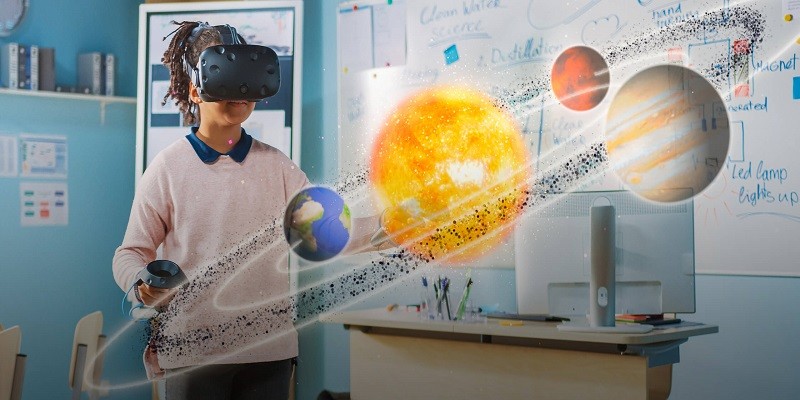Last Updated on May 9, 2025 by Jim C.
Augmented reality in education is transforming learning by providing a new dimension of interactive engagement. Augmented reality (AR) has revolutionized education by introducing an exciting and immersive way of learning.
By seamlessly blending virtual content with real-world environments, AR creates an interactive, engaging, and hands-on experience for students. It enables them to visualize complex concepts, explore virtual objects, and interact with digital content in real-time. Whether it’s bringing history to life, exploring the solar system, or simulating scientific experiments, AR enhances the learning process by providing a new dimension of engagement.
With the ability to cater to different learning styles and capture students’ attention, AR is revolutionizing education and creating limitless possibilities for interactive learning. Teachers and educators are embracing this technology to make education more captivating, meaningful, and effective. As AR continues to evolve, it is reshaping the way students learn, paving the way for a future where education knows no bounds.

The Rise Of Augmented Reality In Education
A new era of learning has emerged in the education sector with the increasing adoption of Augmented Reality (AR). Augmented Reality in education promises to revolutionize the way students learn and engage with the curriculum. By bridging the gap between real-world experiences and digital content, AR opens up a new dimension of interactive and immersive learning.
Read More – Smart Homes: Integrating Technology into Everyday Life
Integration Into Classroom Curriculum
AR seamlessly integrates into the classroom curriculum, enhancing traditional teaching methods by offering interactive and engaging learning experiences.
- Brings abstract concepts to life through 3D models and visualizations.
- Encourages collaborative learning through interactive AR simulations.
Impact On Student Engagement
Augmented Reality provides a novel way to captivate students’ attention and boost their engagement with the learning material.
- Increases student motivation by creating immersive learning environments.
- Enhances retention of information through interactive and memorable experiences.
Benefits Of Augmented Reality In Learning
Augmented reality is revolutionizing the education sector and bringing a new dimension to learning. By integrating virtual elements into the real world, students are provided with an immersive and interactive learning experience that enhances their understanding and engagement. In this blog post, we will explore the benefits of augmented reality in learning, from enhanced visualization and understanding to personalized learning experiences.
Read More – The Blockchain Revolution: Beyond Cryptocurrency
Enhanced Visualization And Understanding
In traditional learning environments, students often rely on textbooks and static images to grasp complex concepts, making it challenging to visualize and understand abstract ideas. With augmented reality, students can now bring these concepts to life by overlaying virtual objects onto their physical surroundings. This technology allows for interactive visualizations that can enhance comprehension and retention of information.
A notable example is the study of anatomy, where students can use augmented reality applications to explore the human body in 3D. By simply pointing their device at a printed diagram or the actual body part, learners can examine organs, systems, and structures up close, making the learning process more engaging and memorable.
Personalized Learning Experience
One of the significant advantages of augmented reality in education is its ability to deliver personalized learning experiences. Each student has unique learning preferences and abilities, and augmented reality can cater to these individual needs.
With augmented reality, students can access content that is tailored to their specific learning styles and pace. This technology can adapt to different levels of difficulty, providing additional explanations or challenges based on the student’s proficiency. This personalized approach not only promotes a deeper understanding of the subject matter but also boosts student motivation and confidence.
Besides, augmented reality can facilitate collaborative problem-solving and teamwork by allowing students to interact with virtual objects together. This interactive element encourages active participation and fosters a sense of shared learning, which is essential in preparing students for real-world scenarios that require collaboration.
Challenges And Limitations
While augmented reality (AR) presents numerous opportunities for revolutionizing education, it also comes with its fair share of challenges and limitations. In this section, we will delve into two key areas that educators and education systems need to address to fully capitalize on the potential of AR in the classroom.
Read More – Virtual Reality: Bridging the Gap Between Digital And Physical Worlds
Access And Equity Issues
One of the primary challenges surrounding the implementation of augmented reality in education is the issue of access and equity. AR technologies often require specific devices, such as smartphones or tablets, that not all students may have equal access to. This lack of access can create disparities in learning experiences between students and hinder the integration of AR into the curriculum.
Additionally, the cost associated with AR hardware and software can pose a significant barrier for educational institutions with limited budgets. The need for regular upgrades and maintenance further adds to the financial burden, potentially limiting the reach of AR-based learning experiences.
In summary:
- Access to AR devices may not be uniform among students.
- The cost of AR hardware and software can restrict implementation.
- Regular upgrades and maintenance can strain limited budgets.
Technology Integration Challenges
The successful integration of technology, including augmented reality, into educational settings requires a thoughtful approach. Educators often face challenges when adapting their teaching methods to incorporate AR effectively. They may require additional training and support to fully understand the technology’s potential and explore innovative ways to use it in the classroom.
Furthermore, the integration of AR into existing curricula requires careful planning and alignment with learning objectives. Educators must ensure that the use of AR enhances, rather than distracts from, the learning experience. This requires clear communication and collaboration among teachers, curriculum developers, and technology specialists.
Future Of Augmented Reality In Education
Augmented reality is poised to revolutionize education by offering immersive and interactive learning experiences for students.
Potential Growth In Educational Settings
- Augmented reality can enhance classroom engagement through interactive visuals.
- It provides personalized learning experiences tailored to individual student needs.
- AR applications can facilitate hands-on learning in various subjects like science and history.
Innovation In Learning Tools
- AR technology enables the development of interactive learning apps and simulations.
- Students can explore 3D models and virtual environments to deepen their understanding.
- AR fosters collaboration through shared virtual spaces for group projects and discussions.
Frequently Asked Questions
What Is Augmented Reality In Education?
Augmented reality in education enhances real-world experiences through digital overlays, creating interactive and immersive learning environments.
How Can Augmented Reality Benefit Students?
Augmented reality enables students to engage in interactive and visual learning experiences, improving comprehension, retention, and critical thinking skills.
What Are The Practical Applications Of Augmented Reality In Education?
Augmented reality in education is used for virtual field trips, interactive anatomy lessons, immersive history tours, and engaging language learning experiences.
Is Augmented Reality Accessible For All Educational Institutions?
Yes, augmented reality is becoming increasingly accessible, with various affordable apps and platforms catering to diverse educational settings and budget constraints.
Can Augmented Reality Enhance Teacher Instruction?
Augmented reality empowers educators to deliver dynamic and interactive lessons, fostering student engagement and understanding through immersive visual aids.
Conclusion
Incorporating augmented reality in education enhances student engagement and fosters interactive learning experiences. The potential for AR to revolutionize traditional teaching methods is tremendous. By integrating this innovative technology, educators can create immersive lessons that cater to diverse learning styles.
Embracing AR opens new horizons for educational advancement and student success.

